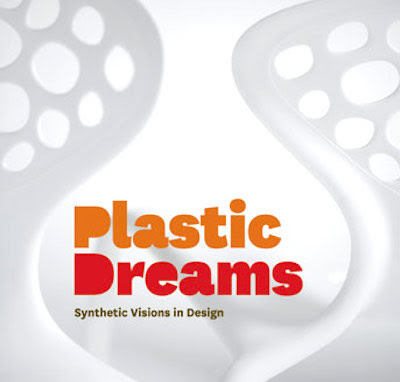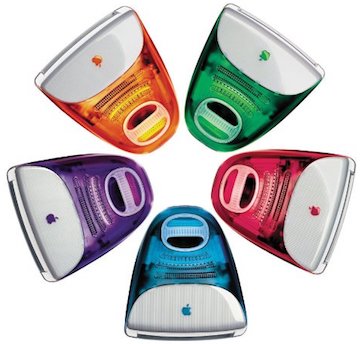

Plastic Dreams: Synthetic Visions in Design, by Charlotte and Peter Fiell, features 120 “landmark designs” manufactured from plastic since 1925. There are full-page colour photographs of each product, and concise essays on their design and significance. The book comes in an orange plastic slipcase designed by Edson Matsuo.
The 1930s was “the First Modern Plastic Age”, due in part to the Great Depression: “The rapid expansion of plastics usage that occurred during this period was, of course, inextricably linked to the constrained economic climate of the 1930s.” Highlights from this era include beautiful Art Deco appliances such as the DBH 1001 telephone, the Kodak Baby Brownie camera, and the Ekco AD-65 radio, all made from Bakelite.
Plastic’s second golden age was the 1960s, when “a vast range of synthetic polymers and moulding processes were available to designers.” Sixties plastic products include the single-moulded Panton chair (“one of the most important chairs of all time”) and the Valentine portable typewriter (“a quintessential Pop design that celebrated the Plastics Age of the 1960s”).
Like Plastic Dreams, Slyvia Katz’s earlier book Plastics also included an introduction tracing the history of plastic design, and a plates section illustrating products chronologically. Katz’s book was the first history of plastics in industrial design, though Plastic Dreams benefits from larger photographs, a bibliography, and coverage of more recent products such as the Apple iMac.
Plastic Dreams was published twenty-five years after Katz’s Plastics, and the two books reflect shifting attitudes towards plastic. Katz writes in her introduction: “This book is a celebration of plastics.” She argues that plastics “make modern life richer, more comfortable and convenient, and also more fun.” Her enthusiasm is unqualified, and sometimes excessive: “Plastics are truly magical because they are created by pure alchemy.”
Like Katz, the Fiells acknowledge the value of plastics: “they are simply one of the most important and useful materials known to man.” However, they also recognise the problems plastic creates: “our use of plastics is still too often marked by wastefulness”. They conclude that, “although ambivalence surrounds the use of plastics both in design and in our everyday lives, it would nonetheless be difficult to conceive of a world without them”.
On its back cover, Plastic Dreams is described as “the definitive guide to plastics in design.” It’s certainly the most authoritative and attractive survey of plastic as a design medium. The Fiells have co-written numerous design books, including Modern Furniture Classics, Industrial Design A–Z, Design of the 20th Century, and The Story of Design. Plastic Dreams is the first book from their independent publishing house, Fiell.
The 1930s was “the First Modern Plastic Age”, due in part to the Great Depression: “The rapid expansion of plastics usage that occurred during this period was, of course, inextricably linked to the constrained economic climate of the 1930s.” Highlights from this era include beautiful Art Deco appliances such as the DBH 1001 telephone, the Kodak Baby Brownie camera, and the Ekco AD-65 radio, all made from Bakelite.
Plastic’s second golden age was the 1960s, when “a vast range of synthetic polymers and moulding processes were available to designers.” Sixties plastic products include the single-moulded Panton chair (“one of the most important chairs of all time”) and the Valentine portable typewriter (“a quintessential Pop design that celebrated the Plastics Age of the 1960s”).
Like Plastic Dreams, Slyvia Katz’s earlier book Plastics also included an introduction tracing the history of plastic design, and a plates section illustrating products chronologically. Katz’s book was the first history of plastics in industrial design, though Plastic Dreams benefits from larger photographs, a bibliography, and coverage of more recent products such as the Apple iMac.
Plastic Dreams was published twenty-five years after Katz’s Plastics, and the two books reflect shifting attitudes towards plastic. Katz writes in her introduction: “This book is a celebration of plastics.” She argues that plastics “make modern life richer, more comfortable and convenient, and also more fun.” Her enthusiasm is unqualified, and sometimes excessive: “Plastics are truly magical because they are created by pure alchemy.”
Like Katz, the Fiells acknowledge the value of plastics: “they are simply one of the most important and useful materials known to man.” However, they also recognise the problems plastic creates: “our use of plastics is still too often marked by wastefulness”. They conclude that, “although ambivalence surrounds the use of plastics both in design and in our everyday lives, it would nonetheless be difficult to conceive of a world without them”.
On its back cover, Plastic Dreams is described as “the definitive guide to plastics in design.” It’s certainly the most authoritative and attractive survey of plastic as a design medium. The Fiells have co-written numerous design books, including Modern Furniture Classics, Industrial Design A–Z, Design of the 20th Century, and The Story of Design. Plastic Dreams is the first book from their independent publishing house, Fiell.


